Gitcoin 2.0 White Paper: Donation Equals Growth
Original Title: 《Gitcoin 2.0 Grants = Growth》
Authors: Kevin Owocki, Meg Lister
Compiler: tiao
Introduction
As a leader in the Ethereum ecosystem, Gitcoin is known for its pioneering Gitcoin Grants program, which aims to support public goods through Quadratic Funding (QF). Launched in 2019, the program has raised over $59 million for public goods that enrich the Ethereum ecosystem. Notably, it was the first to introduce the groundbreaking Quadratic Funding model, making Gitcoin Grants the largest QF initiative in the web3 space to date.
Like many tech startups, Gitcoin explored various products and models—including tech accelerators, hackathons, and bounty platforms. In 2019, we achieved success in raising funds for public goods through the QF model. We refer to this phase as "Gitcoin 1.0"—we had gained momentum but had yet to realize the potential and scale of donation projects.
Gitcoin 1.0 was utilized by many top leaders in the space, including Ethereum founder Vitalik Buterin, and significant protocols like Walletconnect, Uniswap, Yearn, and 1inch exchange. Gitcoin has been an early funding source for many outstanding ecosystem contributors (and validators of their labor), including David Hoffman (Bankless), Austin Griffith (Build Guild), Anish Agnihotri (Ritual), Carl Cervone (OSObserver), and others.
Gitcoin has recently completed its transition from 1.0 to 2.0. This shift has been driven by numerous market changes, including the expansion of the Ethereum ecosystem with the rollout of L2, the growth of open-source development, and the increasing popularity of donation projects. Gitcoin's transformation can be categorized into the following aspects:
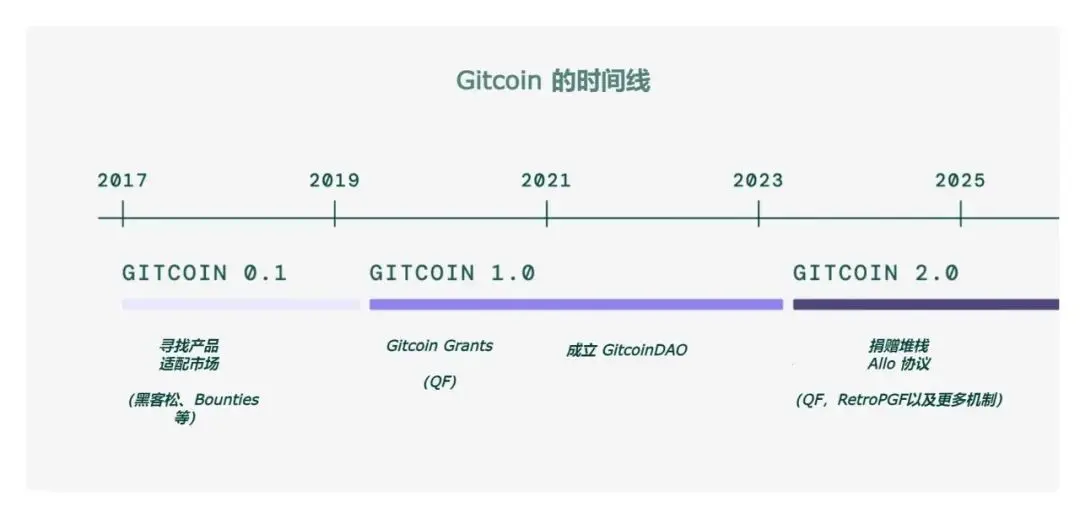
Figure 1: Gitcoin Timeline
- Transitioning from a centralized platform operated by Gitcoin to a modular product and protocol suite that anyone can use and build upon.
- Evolving from solely QF to multiple types of capital allocation mechanisms, including QF, Direct Grants, and Retroactive Public Goods Funding (RetroPGF).
- Expanding from being deployed solely on the Ethereum blockchain to being deployed across multiple EVM-based networks (Optimism, Arbitrum, Base, Polygon, zkSync, Scroll, Avalanche, etc.).
The innovations of Gitcoin 2.0 (which will be detailed in this white paper) position it as a key force in reshaping public goods donations and fostering ecosystem growth. This initiative represents not only a technological advancement but also a beacon of social progress, heralding a new era of empowered communities in the crypto space. In the upcoming on-chain era, Gitcoin is committed to defining and developing the scope of capital allocation—especially in public goods donations.
1. Gitcoin 2.0
As of January 2024, Gitcoin has hosted 19 rounds of QF donation projects, distributing over $59 million to early-stage builders and other beneficiaries. Some of Gitcoin's earliest grant recipients, such as Uniswap, Optimism, and Bankless, have graduated from the donation projects and have raised and run their own donation rounds. Gitcoin's brand and influence have significantly grown over the years, becoming one of the most recognized organizations in the web3 space. Gitcoin collaborates with a range of well-known organizations, including crypto-native organizations like Coinbase and the Ethereum Foundation, as well as organizations interested in the crypto space, such as UNICEF and the American Cancer Society.
In these 19 rounds, we have witnessed the tremendous impact of capital allocation. Organizations that can make effective funding decisions to invest in their ecosystems experience higher builder activity, user growth, and transaction volume—in short, grants create growth.
Capital allocation is a straightforward concept: it is the act of deciding how to distribute funds or resources. If you have ever paid a bill, taxes, or transferred money to a friend for a meal, you have allocated capital. For most individuals, capital allocation is a task, but for many, it is a full-time job: governments and grant organizations spend significant time and money figuring out the processes, logistics, and decision-making involved in allocating capital. At scale, capital allocation inevitably falls into the traps of gatekeeping, competitive decision-making, and a lack of transparency and accountability.
With programmable smart contracts, blockchain and cryptocurrency provide incredible advantages for efficiently, effectively, and transparently allocating capital. Gitcoin has seized this advantage: from governance, creation, management to distribution, moving the entire grant project on-chain. On-chain and open-source grant projects also allow us to build a network of developers, grant projects, and capital allocators in web3—all of which ultimately benefit the Gitcoin ecosystem.
Gitcoin has previously delved into various forms of grant design, primarily focusing on achieving fair and effective methods for implementing QF. We created a marketplace for this grant mechanism, expanding allocated grants from $0 to millions. We are now beginning to see the impact of new mechanisms, such as Direct Grants and RetroPGF, and are prepared to scale them.
The crypto ecosystem has raised over $1 billion through 5,900 grants and is continuously scaling to support the immense growth goals of blockchain. The potential of capital allocation extends beyond grants; it represents a disruptive category, and Gitcoin, along with its extensive network of partners and protocol builders, is poised to lead in this space. The North Star goal of raising $1 billion in grants is both a radical growth target for Gitcoin and merely the beginning of possibilities.
2. Capital Allocation: The Next Frontier of Growth
The most easily recognized form of capital allocation is government spending. It also perfectly illustrates many limitations of traditional capital allocation.
Governments accumulate funds through taxation, and every individual is obligated to participate. In theory, the collected funds are meant to benefit the collective interests of taxpayers. This system also highlights many issues faced by traditional capital allocation methods:
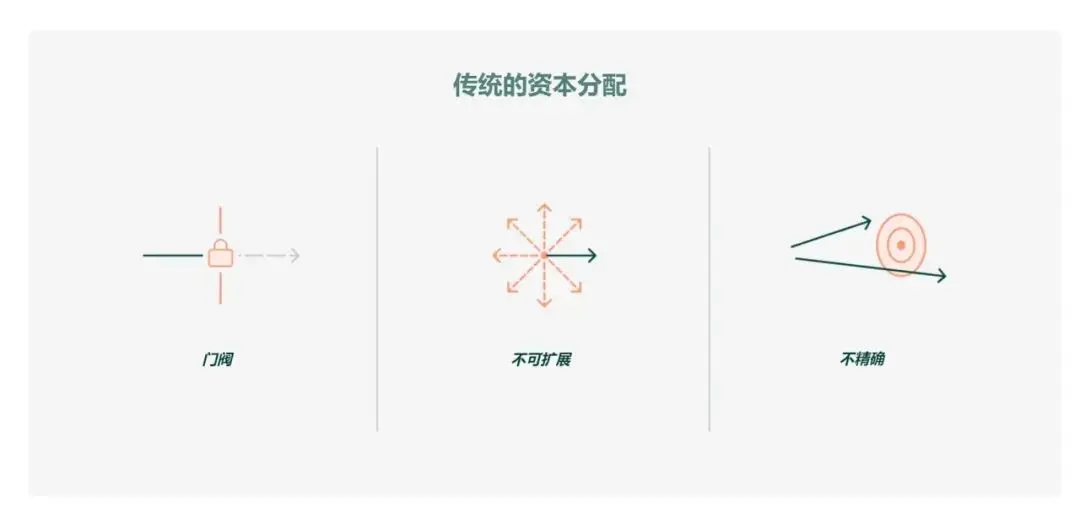
Figure 2: Traditional Capital Allocation
- Gatekeeping: A few decision-makers may become power brokers, unwilling or unable to democratize.
- Not scalable: Unable to leverage the native advantages of the internet (convenient access, direct-to-consumer interfaces) and Ethereum (trustless neutrality, composability, transparency, democratic decision-making, censorship resistance).
- Not precise: Lacking the ability to manage large amounts of information programmatically at scale, they cannot allocate capital resources precisely.
Over the past 30 years, technological advancements have created opportunities to address the persistent issues of capital allocation. The internet introduced an unprecedented ability to communicate at scale. Blockchain created a transparent ledger that reports activities and establishes accountability mechanisms through easily accessible data and the immutability of on-chain behavior. By innovating with internet speed and blockchain transparency, we will unlock a new way of capital allocation. This will enable communities to support the things they care about in a more efficient and locally aligned manner.
Ethereum-based capital allocation can be:
- Democratic: The ability to easily create and run on-chain voting allows governance to reflect the will of participants.
- Accessible: Anyone can participate via a web page or mobile app, requiring only an internet connection.
- Transparent: Utilizing the core feature of blockchain, an immutable public ledger, anyone can view audit trails.
- Powerful: Using programmable smart contracts, capable of precisely allocating resources at scale.
- Evolutionary: Anyone using open-source software can easily fork and modify existing methods to further develop them according to their needs.
The time to solve the capital allocation problem is now. We can build capital allocation systems that address the above limitations. We can eliminate barriers to adoption by emphasizing the transparency and extensibility of these systems. We can build more effective, efficient, or novel capital allocation methods through democratic voting and creating convenient participation systems.
In today's web3, hundreds of DAOs are deploying significant capital to fund the growth of their ecosystems. These DAOs unlock new global markets, allowing ideas and APIs to become products and be adopted at a much faster pace than before.
Building on the success of QF and web3 grants, Gitcoin is positioned to define and lead a new category of capital allocation. Through its grant projects, Gitcoin has unparalleled on-chain capital allocation experience. We are exceptionally confident in this potential, to the extent that we have spent two years building a protocol and product suite that enables anyone in web3 to easily engage in new capital allocation methods.
3. Gitcoin = Grants = Growth
While the market for web3 capital allocation tools is currently limited to organizations with token treasuries, we expect this market to grow exponentially. Over the next decade, we predict that more assets will transition on-chain and be tokenized. This includes financial assets (from fiat to investment instruments) as well as non-financial assets like real estate, artwork, or other physical assets. As more assets become available on-chain, the use cases for capital allocation will continue to grow in breadth (common, easy-to-use systems) and depth (novel, unimaginable methods).
However, 11 years after the emergence of Ethereum, web3 is still in its early growth stage. This technology still lacks key features that would make it more trustworthy and accessible. Only 4% of the global population holds cryptocurrency. There is a gap between the potential of blockchain and the actual use cases and adoption today.
Bridging this gap means attracting more builders and developers who create the next generation of infrastructure and applications that appeal to future users and unlock the next generation of use cases. Aspiring to build super-scaled organizations requires attracting new builders at super-scale. This scale far exceeds the capabilities of traditional BD or investment channels, which are too slow and inefficient. Traditional web2 marketing, driven by closed data collection, also fails to operate in a user-centric on-chain world.
Grants have become the core driver of growth in web3, capable of both recruiting new builders and incentivizing existing ones. When tokens are distributed as incentives or compensation, new builders are drawn in by grants. These grants are often disbursed in the early stages of projects, providing crucial funding, visibility, and validation. Many early-stage builders choose to apply for grants rather than seed funding. Grants can be distributed faster than VC capital and come with additional benefits, including project exposure and connections with other grantees in the ecosystem. Unlike VC funding, grants do not require builders to give up equity. By distributing funds in their ecosystem's native currency, grants create positive-sum outcomes: if a project succeeds, the value may accumulate.
The ability of grants to create positive-sum outcomes through token distribution is also crucial for builder retention. Not only can all organizations in the ecosystem share in its success, but the tokens distributed through grants also grant builders ownership and governance rights within the ecosystem. This enables them to play a key role in policies and investments that directly affect their projects.
Grants = Growth—this is not just theoretical; it has been validated by experience in the past four years of Gitcoin Grants!
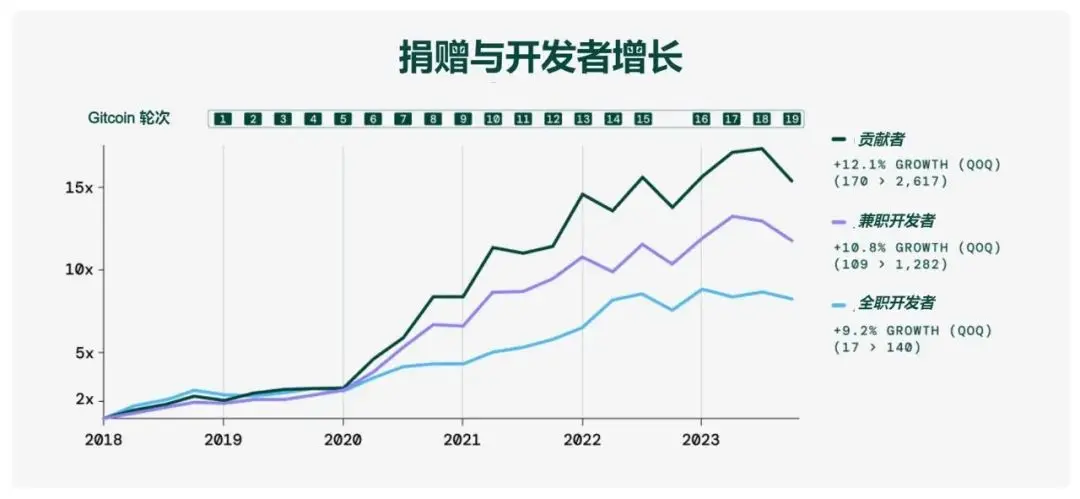
Figure 3: Grants and Developer Growth
The chart above shows a strong correlation between the funding received by projects and the value-additive activities. Since 2019, for every $1 million paid through Gitcoin Grants, there are 7 full-time developers still active on the project. Considering the crowdfunding multiplier effect, this ratio grows to 13 retained full-time developers for every $1 million in the matching pool. When you compare these numbers to the approximately 0.1 developer retention for every $760 billion in VC funding, these figures become particularly impressive.
4. Beyond Grants
We believe that the impact and reach of the next generation of capital allocation will span many industries, from web3 social and marketing to traditional sectors—such as crowdfunding, real estate, scientific research, and more. The next generation of capital allocation represents not only a technological evolution but also an evolution in our social practices regarding how we organize, exercise purchasing power, and own assets.
While Gitcoin's initial focus was on providing grants for DAOs and other tokenized communities, we believe that as more assets across industries become tokenized, a vast design space will emerge where we can reimagine capital allocation across various sectors. These sectors include but are not limited to:
Funding the development of DAO ecosystems
Funding scientific research
Funding environmental and social impact initiatives
Funding charitable initiatives
Funding development projects for cities, counties, and states
Funding capital formation and economic growth
Each of these sectors will require higher levels of strategic development, thought leadership, stakeholder engagement, and new applications that meet their specific needs. The Gitcoin network has already run many pilots in these sectors, including collaborations with the American Cancer Society, DeSci projects, UNICEF, and the city of Boulder, Colorado.
The potential for capital allocation in these sectors has yet to be fully explored, but we can already sense the transformative nature: just look at how email has changed written communication. Today, humans send 100 times more messages than physical mail sent decades ago. We believe that the future of capital allocation will involve funding decisions with higher capacity and resolution than ever before.
Over the past few decades, the evolution of capital allocation has exhibited a skeuomorphic style: from physical cash to physical checks, and further to virtual checks (credit cards). Credit cards and the internet introduced faster banking, enabling e-commerce and crowdfunding platforms (like Patreon, Kickstarter, or Gitcoin Grants). It is difficult to predict the next possibility, but we will discover it together through the Gitcoin network. Because it is built on blockchain, we believe it will bring more transparency and accountability to organizations while providing individuals with greater purchasing power through new collective ownership. We can infer the contours of this frontier based on the properties of blockchain. It will be faster, more democratic, more emergent, and more powerful than anything that has existed before.
5. Our Solution
5.1 Architecture
The design space for capital allocation is vast. While our first and primary focus is on addressing the use case of grants, we have designed a modular solution stack intended to be scalable or repeatable for many different use cases.
The stack primarily consists of three layers:
Protocol Layer
Application Layer
Program Layer
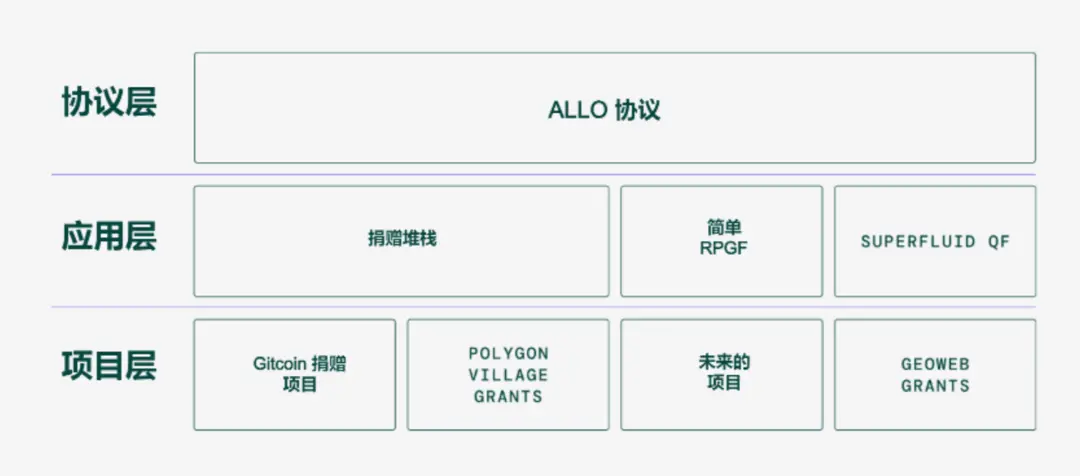
Figure 4: Stack Architecture
First and foremost, the most scalable is the Protocol Layer. The Allo Protocol, or Capital Allocation Protocol, is designed to be an infinitely flexible and scalable, yet trustworthy and precise method for capital allocation.
Next, the Application Layer. The Gitcoin Grants stack is a no-code platform for running grant projects. This application currently allows grant managers to create, manage, and run QF, Direct Grants, and RetroPGF, and projects can expand to any grant mechanism with strong demand. The Grants stack is an open-source decentralized application (dApp) that allows the community to develop companion applications or even fork the application to create customized versions.
Finally, the Program Layer. This is the longest-lasting and most Gitcoin-specific part of the stack. The Gitcoin Grants program is a powerful tool for spreading and nurturing the power of grant projects within the community. It has run 19 rounds of grants, distributing over $59 million to the Ethereum ecosystem.
In this white paper, we will delve into the protocol layer first, followed by the application layer and program layer.
5.2 Protocol Layer—Allo Protocol
The Allo Protocol is the cornerstone of this design space. It has a simple, universal architecture that can be easily customized for a wide range of use cases. The design of the Allo Protocol embraces both breadth and depth.
- Breadth is reflected in its strategy library, enabling the Allo Protocol to support many different types of capital allocation (QF, RetroPGF, Conviction voting, etc.).
- Depth is reflected in the stable, secure, and robust core protocol that handles capital pools and permissions for these pools. Each pool allocates funds according to a specific strategy, customized to the needs of developers. The power of Allo lies in its ability to deepen impact through precise capital allocation.
The Allo Protocol has three key components:
- Tokens: Contributors send tokens into the funding pool.
- Registry: The registry is structured data of potential participants who are eligible to allocate tokens.
- Strategy: The strategy determines how tokens are allocated and distributed to recipients.
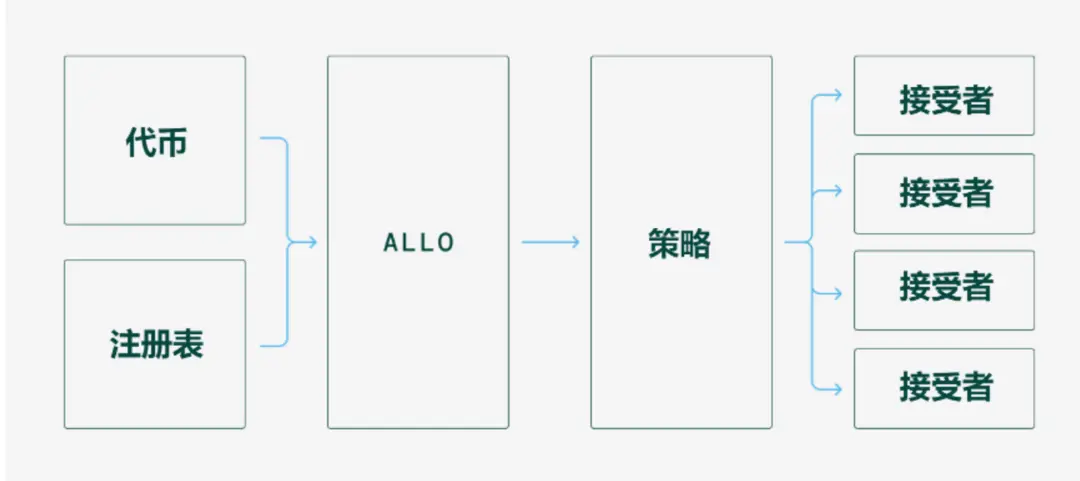
Figure 5: Allo Protocol
There are two input data types entering the funding pool (marked as "Allo"): tokens and the registry. The registry is designed to define what we want to fund and collect information about those things. The project registry is the core foundation of data intelligence about project content, members, their reputation, and influence. In addition to the registry, funding can also be provided to the pool by depositing individual tokens.
Funds are held in pools, which are rigorously audited, simple, and modular contracts. Strategies determine how and when funds are released from these pools. Strategies can decide whether funds are allocated as a one-time distribution or flow over specific milestones or time periods, etc. Strategies can also determine the decision-making process for releasing these funds: whether by a single signer, a voting committee, or QF.
By building the Allo architecture in a modular way, we will be able to adapt to many different types of capital allocation, becoming a design space for the evolution of capital allocation.
Over time, we believe that the most in-depth and extensive capital allocation strategy library will make Allo contracts a powerful and easy-to-use tool for building capital allocation anywhere in the world.
We aim to make Allo a reliable resource and an easy-to-integrate tool for developers who want to build capital allocation into their applications. These integrators will expand the Gitcoin network and act as decentralized explorers and researchers of the capital allocation design space. They will have the opportunity to align with Gitcoin's incentives while building—rewarded through our Citizens Grants program (operating on the Allo protocol, of course).
To learn more about our expectations for what people will create using Allo, please read the Rainbowpaper focused on the design space.
5.3 Application Layer—Grants Stack
The Grants Stack is built on top of the Allo Protocol and is the primary application within the Gitcoin ecosystem. It is designed to be a trusted, enterprise-grade tool. It also serves as a reference application for builders of the Allo Protocol, as it is open-source and can be forked.
The Grants Stack is an easy-to-use tool that helps any grant manager create, manage, and run grant rounds. It productizes Gitcoin's years of experience in running successful grant rounds, from grant setup to builder profile creation and applications, to community-facing grant or participation interfaces. The Grants Stack recognizes the heavy coordination costs between grant managers, builders, and the community—not to mention all the tools and processes each uses. We strive to make this as seamless as possible through automation, transparency, and modularity in our product for optimal coordination. Additionally, as an on-chain product, it is ready to use out of the box, with high standards for funding decision transparency and accountability.
The Grants Stack is focused on several core areas to provide grant managers with the tools for successfully running grant projects. We believe the success of grant projects is driven by:
Engaging the community to crowdfund and identify the needs for grant projects
Creating the best and brightest builder network
Providing transparency and accountability in grant decision-making
Measuring and enhancing the impact of grant projects
The Grants Stack currently supports various grant types: QF and Direct Grants. We are also continuously experimenting and searching for new types of grant mechanisms. When new grant mechanisms emerge, we will strive to gain sufficient expertise to productize them effectively. A great example is EasyRetroPGF.xyz. It was initially used by Optimism for RPGF3, and we have now open-sourced this tool for anyone in the web3 grant community to host and run. As we learn about the effectiveness and power of Retro PGF, we may integrate these features into the Grants Stack, making them accessible for grant managers in a no-code, stable environment.
We anticipate that the community will build many experimental web applications, including supplementary tools (like reporting tools or discovery tools) and novel capital allocation mechanisms (including conviction voting, whitelist voting, or EasyRetroPGF.xyz). These create an innovative flywheel for the grant ecosystem, allowing the Grants Stack to remain a stable, trusted solution while staying at the forefront of grant innovation.
5.4 Program Layer—Grants Program
The goal of the Gitcoin Grants program is to fund public goods that promote the growth and adoption of the Ethereum ecosystem and contribute to our Gitcoin North Star—total donations made through Allo (GMV). By focusing the program on the growth of the Ethereum ecosystem, we can draw insights from internal experiments and share public goods within the Ethereum network.
In an early-stage industry like web3, new trends and developments emerge constantly. Becoming practitioners of capital allocation techniques enables Gitcoin to stay at the forefront of innovation and develop a community of expertise that influences our grant projects and products.
The Grants program has also created tremendous network effects for Gitcoin. Over the past four years, we have raised nearly 4,000 unique grants. Gitcoin now has the largest open-source software builder community in web3, making our platform particularly attractive to organizations looking to recruit new builders and builders seeking new funding opportunities. The Grants program also supports the grant managers in the market. Many grantees have graduated and become partners of Gitcoin, running their own grant rounds through the Grants Stack and building applications based on the Allo protocol.
6. Conclusion
The evolution from Gitcoin 1.0 to Gitcoin 2.0 marks a significant milestone in the field of capital allocation, particularly in the realm of public goods donations both within and outside the Ethereum ecosystem. By shifting to a more decentralized, modular approach and expanding its grant mechanisms beyond QF, Gitcoin stands at the forefront of a movement toward more democratic, efficient, and transparent capital allocation practices. The expansion to other blockchain networks signifies an increase in Gitcoin's influence, providing a scalable and flexible platform for funding public goods across the entire web3 space.
This transformation not only enhances Gitcoin's ability to support the growth of the Ethereum ecosystem but also explores a new frontier in how to fund and support public goods in a decentralized world. Furthermore, the implementation of Gitcoin 2.0 embodies the potential of blockchain technology to revolutionize traditional capital allocation methods. By leveraging the advantages of programmable currency, smart contracts, and decentralized governance, Gitcoin demonstrates how to make capital allocation more convenient, precise, and scalable.
As tokenization engulfs the world, the total addressable market (TAM) for capital allocation tools may grow exponentially. Gitcoin's commitment to refining and expanding the possibilities of capital allocation—especially through grants—highlights the transformative power of web3 technology in addressing the long-standing challenges of funding and resource distribution. As Gitcoin continues to explore and develop this vast design space, it is paving the way for a future where capital allocation is not only more efficient and transparent but also more aligned with the values and needs of the communities it serves.
7. Disclaimer
Non-financial or tax advice. This white paper is purely educational and is not an investment recommendation or a solicitation to buy or sell any assets or make any financial decisions. Additionally, Gitcoin contributors hold crypto assets.
This document is not Gitcoin's official strategy unless approved by Gitcoin governance.
8. Acknowledgments
We would like to thank those who support the Gitcoin Grants program, including our grantees, donors, and matching pool partners.
We also thank the many collaborators on this document. MathildaDV edited the document, Harry Eastham designed it and created the microsite. Carl Cervone and Umar Khan provided data analysis mentioned in the Grants = Growth section.









